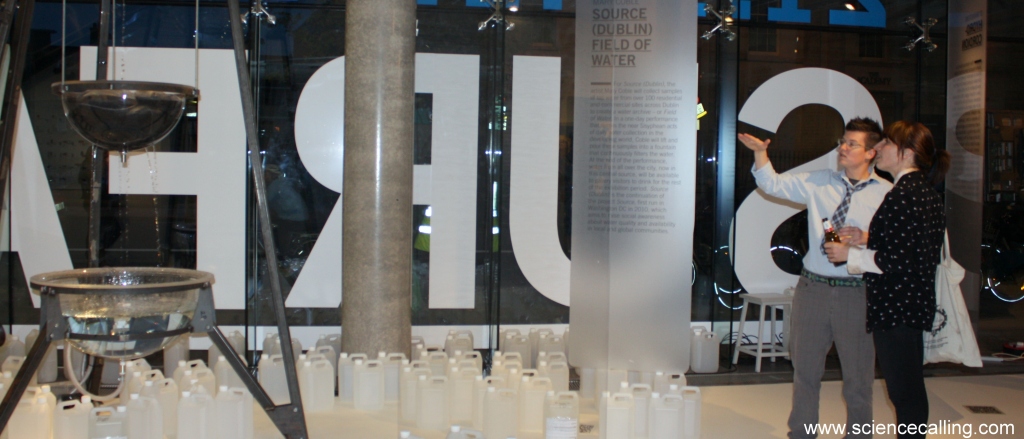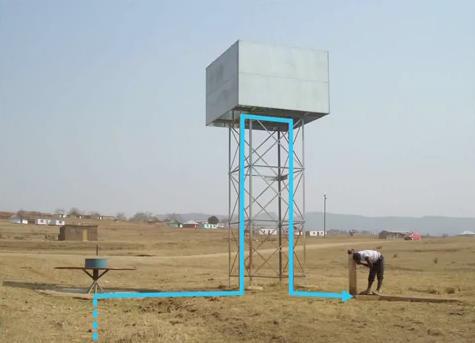Ireland is renowned for the amount of water that falls on it every year. You would imagine that water shortages are not commonplace here and water conservation seems unnecessary with the unrelenting hammering we get from the skies. Last year’s water shortages showed us all that this is no longer the case. Along with many others, my house was under water restrictions for almost a month last winter, with complete loss of supply for a number of days. The Science Gallery’s latest exhibition Surface Tension, The Future of Water is very timely as we approach the winter season again. I was very excited when this exhibition was announced last June and wrote a previous post, Wine without water, which was inspired by it. Last night, I explored the exhibition at its preview party.
The Director of the Science Gallery, Dr Michael John Gorman, opened the exhibition remarking how the problems with Dublin’s water supply last winter were a “powerful reminder that water issues affect us all”. No longer are water shortages about far away drought-ridden countries! With this in mind, I was delighted to see that Dublin City Council were involved in the creation of some exhibits. Potential sources of water for the Dublin area can be viewed as well as a map of the water usage in certain Dublin households. Dublin has often been the drain of young people from the west of Ireland but water could soon be added to the resources migrating eastwards.

As I wandered around the gallery I realised there was a lot I didn’t know about the amount of water we consume on a daily basis. The Virtual Water Project gave me a clear illustration of just how much water goes into making a product. I was shocked to learn that the bar of chocolate I ate on the way in took a phenomenal 2,400 litres of water to produce! This message is repeated in the Science Gallery Cafe where the water footprint of dishes has been added to its menu. Hidden (photo on left) demonstrates the variety of water usage during manufacturing of materials. The amount of water contained in each bottle reflects the volume used to create the bottle’s stopper.
Design Consultant, Jane Withers, who is a curator of the exhibition also spoke at the opening remarking how it spurred “a crossover of ideas and an interactive debate between artists, designers, engineers and scientists”. The Sea Chair Project was the best example in my opinion of this interaction. This project aims to solve the problem of plastic waste in our oceans by turning retired fishing trawlers into plastic chair factories. An innovative solution which mixes elements of design and engineering.
There could not be an exhibition on the future of water without mention of the developing world. Many exhibits involve projects and ideas about supply and management of water in these areas. Source (Dublin) Field of Water (see photo above) is a project where water will be collected from over 100 sites around Dublin to mirror how water is trekked many miles on a daily basis in the developing world.
A wall exhibit The Problem with the Playpump explains how a supposedly innovative solution to water supply in South Africa was not as valuable as predicted by interested first world parties. I was fascinated when Ralph Borland, the creator of this exhibit, talked about the PlayPump at IGNITE in Electric Picnic last month:
The PlayPump was designed so that a children’s playground roundabout was used to pump the water. The water was then stored in a water tank which could pay for the PlayPump via billboard advertising. This may have sounded brilliant but in practice adults had to use to roundabout most of the time and it was more laborious to pump water than the traditional hand pump.

These are just a few of the many projects and exhibits on show in the Science Gallery for the next few months. I look forward to revisiting Surface Tension, The Future of Water and exploring exhibits I missed last night. Definitely worth a trip to the city centre.
Surface Tension, The Future of Water runs from today until 20th January 2012 in the Science Gallery, Dublin.

Ag tnúth go mór leis an gceann seo. Tá an Dánlann Eolaíochta thar barr!
I totally agree… it’s a great asset to have in Dublin! Let me know what you think of the exhibition after you pay it a visit.
How do you think of a topic for every week.
Well there’s a load of science to write about but it’s hard to think of a new angle sometimes. Thanks for reading!